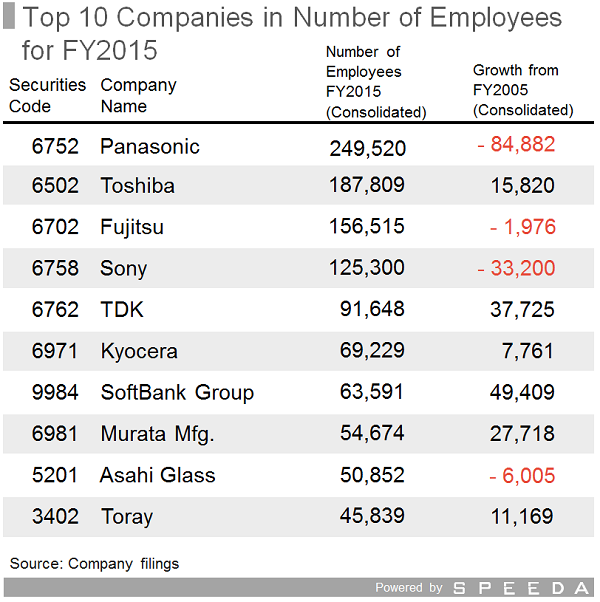A Brief Glance at Japan’s Mobile Communications Related Industries
|
The following is a special edition for industries related to Mobile Communications, featuring the three main telecom carriers in Japan and companies in the smartphone-related field. It is based on the value chain provided in SPEEDA, as well as the fluctuations of fundamental figures disclosed in the securities reports of companies across a ten-year period. |
|
Mobile Communications Play a Key Role in Japan’s Communications Infrastructure Primary telecommunications operators, also known as telecoms carriers, handle data exchanges amongst computers or multiple devices. The value chain centred on mobile communications is detailed in the diagram below. In Japan, with control over devices used in their networks, telecoms carriers have gained a foothold in the networking business, thus exerting powerful influences over content providers. 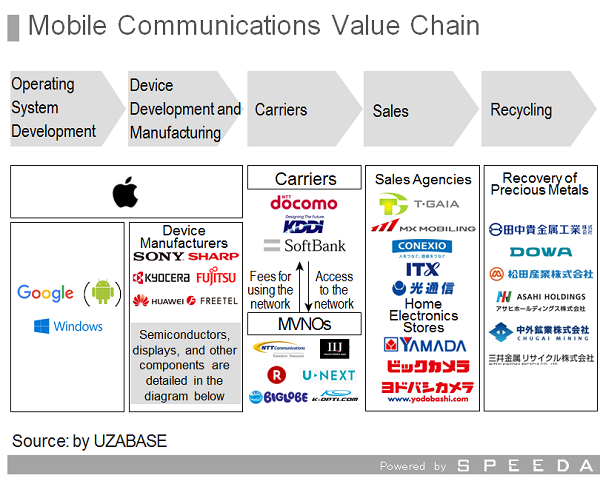 Japanese manufacturers have also established a presence in the hardware production segment, with many electronic components produced in Japan being used in world-renowned, high-end smartphones. Such high value-added products manufactured in Japan include sensors, camera components, and connectors for telecommunication parts and devices, etc. Going forward, these products are expected to demonstrate their supremacy in the IoT market, where growth is expected. 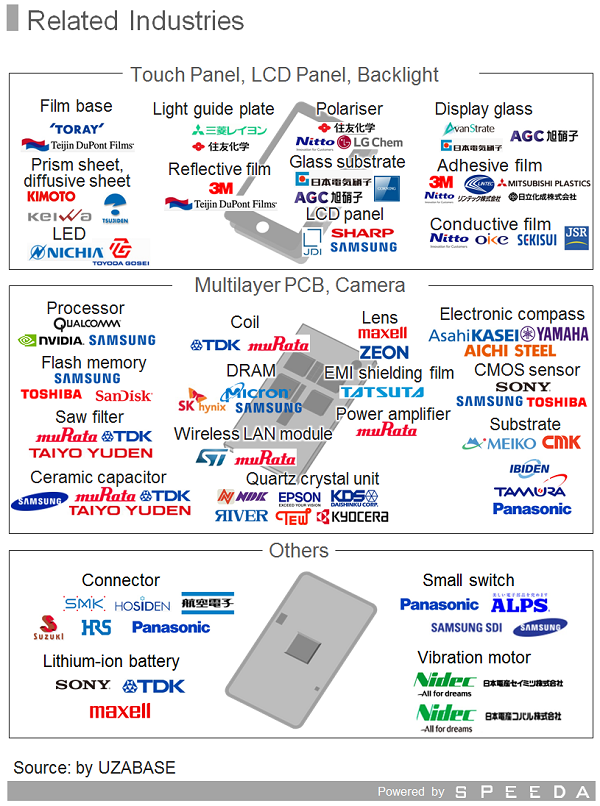 |
|
Industry Trends: Area Expansion and Advancement of Telecommunication Standards The three leading telecoms carriers in Japan are NTT Group, KDDI Group, and SoftBank Group. They handle fixed-line and mobile voice-calling services, and constantly competing for customers. As of end-2016, the total number of mobile voice-calling contracts was 160.71 million contracts; breaking it down, NTT DoCoMo led with 73.59 million contracts, followed by au at 47.83 million contracts, and SoftBank (including Y!mobile) at 39.29 million contracts. In terms of market shares, NTT Group was ranked top with a share of 45.8%, followed by KDDI Group and SoftBank Group at 29.8% and 24.4%, respectively.  Since NTT East and NTT West launched the optical fibre wholesale business in 2015, telecom carriers began to provide service packages that combine optical fibre internet and mobile voice-calling services. Furthermore, following the liberalisation of electricity retail in Japan in April 2016, they are now trying to lock in customers by offering discounts for packaged deals that include electricity. |
|
MVNOs Growing in Presence Mobile virtual network operators (MVNOs), who offer low-price smartphone services, have experienced rapid growth since 2015. The number of such contracts reached 11.5 million as of December 2015, constituting 7.2% of the total number of mobile contracts. In 2015, the number of mobile phone users reached 99.44 million people, and 64.96 million of them were smartphone users. The proportion of smartphone owners has been steadily expanding, increasing by around 8% YoY to an estimated 53.1% share, and further growth is expected in future. |
|
On the Path Towards 5G In the medium term, the fifth-generation (5G) mobile network service is planned for deployment towards the start of the 2020 Tokyo Olympic and Paralympic Games in Japan. The main prerequisites for 5G network connections include 1) large capacity, 2) high speed, 3) low latency and high reliability, 4) simultaneous connections for an extremely large number of devices, and 5) low costs and better power-saving features. The capacity of 5G, which is 1,000 times that of 4G, and its speed, which is 100 times higher than that of 4G, attract the most attention. |
|
Telecom Carriers Taking Unique Moves with Telecommunication Business as the Foundation Each telecoms carrier is taking unique moves amidst the increasing maturity and structural changes of the mobile communications industry. NTT DoCoMo NTT DoCoMo, one of the three biggest mobile communications operators in Japan, holds the top share in the number of contracts domestically. NTT DoCoMo contributes more than 50% of the NTT Group’s operating profit, and features an extremely low debt-to-capital ratio and high financial stability. NTT DoCoMo’s operations include the mobile communications business and the smart life field business, which includes the smart life business as well as international, value-added, and auxiliary services. The company aims to expand its mobile communications business, as well as the smart life business going forward. In addition to its “dmarket” service, which has yielded significant results, the company also focuses on the “+d” service, a value-added service it co-created with outside partners. KDDI KDDI offers mobile communication services for individual customers under the “au” brand, broadband internet services, as well as ICT solutions for corporates both at home and abroad. It also has the major CATV operator JCOM under its umbrella. In the company’s fundamental domestic communications business, KDDI is advancing its 3M strategy of “Multi-Use”, “Multi-Device”, and “Multi-Network”. Furthermore, it is also growing and expanding its financial products, as well as electricity-related and payment services, aiming to maximise the “au Economic Zone”. SoftBank Group SoftBank Group has achieved growth with the internet business being its business foundation. Within the information and telecommunications sector, the company operates diversified businesses including Domestic Telecommunications, Sprint, Yahoo, Distribution, and ARM. In June 2015, it launched the sale of personal robot “Pepper”. The company also focuses on its investment business and provided funding for multiple companies such as Alibaba, China’s largest auctions/e-commerce website, and Supercell, a global games developer from Finland (sold all shares in 2016). Furthermore, the company established “Vision Fund”, a high-tech investment fund with an asset of USD 100 billion, and this calls for further attention. |
|
Notable Smartphone-Related Hardware Manufacturers The following section will outline the trends of smartphone-related companies. |
|
Ten Years Ago and Now: A Comparison of Figures for Leading Companies The following section compares trends for leading industry players over the FY2005–15 period. The graph below shows the trends in revenue, operating profit, and operating margins. The operating profit value is on the vertical axis, the operating profit margin is on the horizontal axis, and the size of the bubbles represents the amount of revenue. 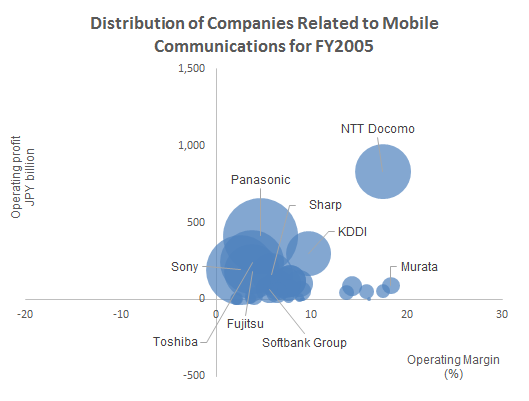  The following section shows trends in market capitalisation, earnings per share (EPS), research and development (R&D), and the number of employees over the ten-year period.  The table above is a list of companies based on the market capitalisation value as recorded in each company’s FY2015 statement. However, the latest figures (as of 21 March 2017) for the three telecoms carriers were as follows: around JPY 10 trillion for NTT Group, JPY 9 trillion for SoftBank Group, and JPY 7.5 trillion for KDDI Group. 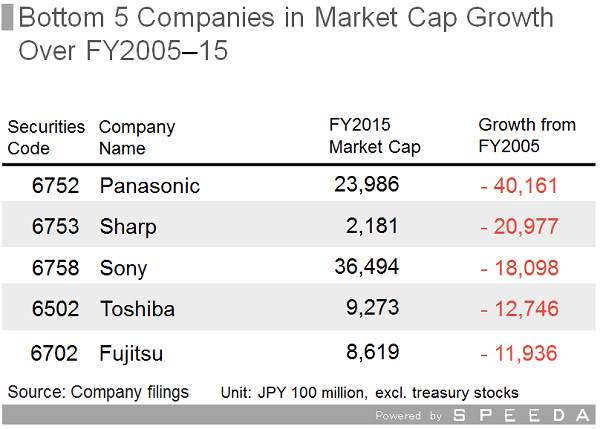 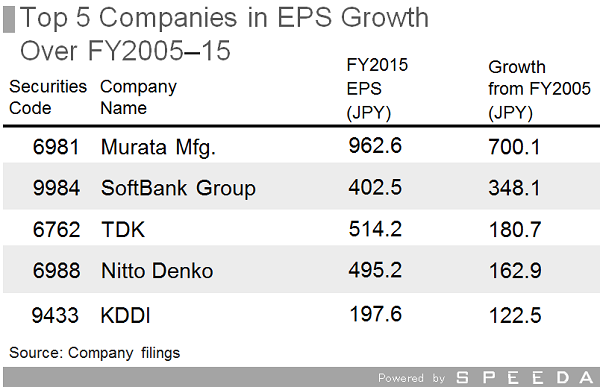 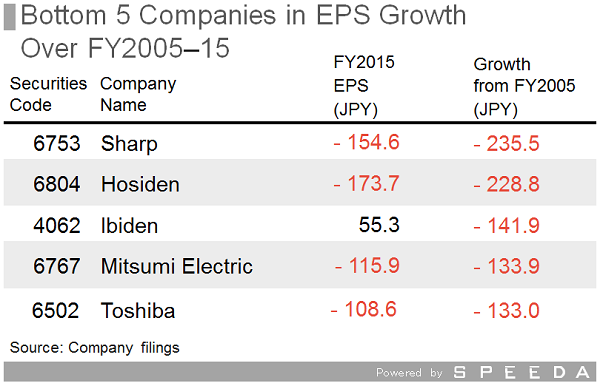 Meanwhile, the EPS comparisons reveal that Murata Manufacturing experienced outstanding growth. Conversely, the majority of the bottom five companies in EPS growth fell into the red. 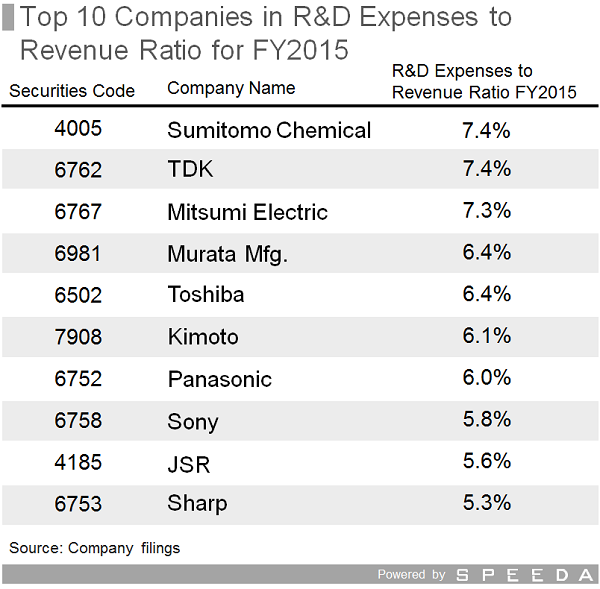
In terms of revenue per employee, many companies showed a decrease compared to the figures ten years ago.  Note: Average salary is based on the data from the companies’ non-consolidated statements. |
|
In Closing: Circumventing the Dumb Pipe Operation Model a Challenge Demand for smartphones came to a full circle, but there is no successor on this horizon as of lately. Smartwatches and smartglasses may be considered valid candidates for that position, but it is unclear whether they will gain traction going forward. Meanwhile, on 27 February 2017, 22 global telecoms carriers and vendors announced their collective support for the acceleration of the 5G commercialisation project by 3GPP to enable the deployment as early as in 2019, instead of the originally proposed 2020. Going forward, 5G network is likely to be a significant driver for the development of various trending technologies such as IoT, as well as self-driving cars, drones, and VR. Earlier, NTT DoCoMo’s former CEO, Ryuji Yamada, commented that when thinking as far ahead as 2020, achieving revenue growth from communication charges will probably be difficult, and the telecoms carrier business cannot prosper for that long. This indicates that avoiding the dump pipe operation model, or providing a neutral networking service for simple data transfers, will be increasingly needed and pose challenges to telecoms carriers. |





